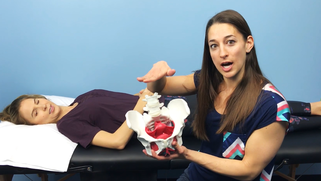|
By Dr. Katie Casto, PT, DPT, PCES  Many women experience pelvic floor related issues like urinary incontinence (leaking urine), bowel dysfunction (constipation, straining, incomplete emptying), pelvic girdle pain, pain with intercourse/penetration, pain with medical exams, needing to use the restroom frequently, etc. Many women are also told just to “do kegels” to help their pelvic floor symptoms. The issue with this blanket recommendation to just “do kegels” is that all too often, the recommendation is made without an actual pelvic floor examination. Let’s discuss what a kegel actually is, and how Kegels may or may NOT be helpful based on the cause of pelvic floor dysfunction. What even is a kegel? A “kegel” refers to a pelvic floor contraction. The pelvic floor is made up of 3 layers of muscles that form a hammock-like or bowl-like shape that support the internal organs of the pelvis (bladder, uterus, and rectum). A pelvic floor contraction is a “squeeze and lift” of the pelvic floor muscles. Importantly, this contraction needs to be followed by a full relaxation of the muscles in order to be effective. A kegel is NOT a butt squeeze or inner thigh squeeze. Pelvic floor contractions aren’t always helpful (and can actually make things worse) because there can be many different reasons as to WHY the pelvic floor muscles are weak or not functioning correctly other than simply not being able to contract strongly. “Kegels” are just one of many tools in the toolbox for pelvic floor health. Let’s talk about 3 common CAUSES of pelvic floor dysfunction, and how treatment strategies differ in each case: Hypotonic Pelvic Floor This is the case most of us are probably familiar with. “Hypotonic” refers to pelvic floor muscles that are generally low tone.
Poor Coordination Sometimes, the root cause of the pelvic floor dysfunction is uncoordinated pelvic floor muscles.
Hypertonic Pelvic Floor A hypertonic pelvic floor refers to pelvic floor muscles that are generally high tone.
In any of these 3 cases, the pelvic floor muscles can be (and likely are) WEAK. However, as you can see that the underlying issue or the “root” of the problem in these 3 cases of pelvic floor dysfunction is entirely different and would require a different treatment approach. This is why blanket statements of “just do your kegels” are largely ineffective and sometimes harmful. Therefore, it is important to see a Pelvic Floor Physical Therapist for a full evaluation to determine what is causing your individual symptoms. A treatment plan should always be individualized to you and your goals for an effective and long-lasting solution. Our Physical Therapists are trained in pelvic floor assessment and treatment and are passionate about helping women recover from pelvic floor dysfunction. Contact us at [email protected] // 512- 207 -0368 to learn more about our pelvic floor treatment options or to speak with a Pelvic Floor Physical Therapist. Reference:
Duvall, Sarah. “Postpartum Corrective Exercise Specialist” Course. Core Exercise Solutions (2020)
0 Comments
Your comment will be posted after it is approved.
Leave a Reply. |
Meet Your TherapistJessica has been in Austin, TX for the past four years. She grew up in Idaho and attended PT school at Idaho State University. She completed an Orthopaedic Residency and became a Board Certified Orthopaedic Clinical Specialist in 2016. Archives
February 2022
Categories
All
|

 RSS Feed
RSS Feed